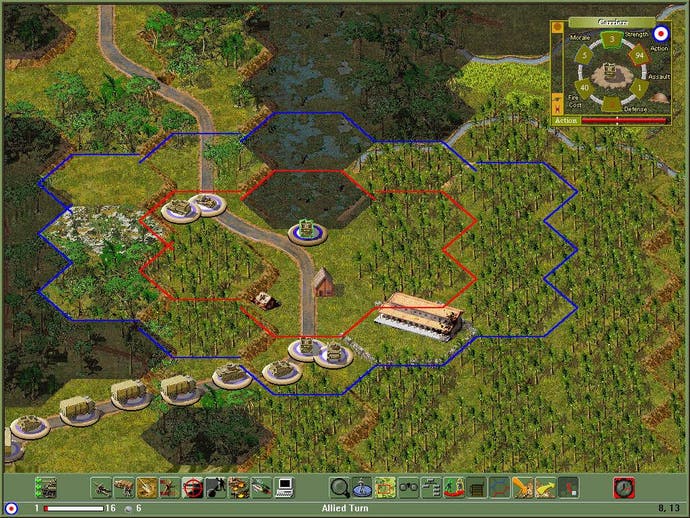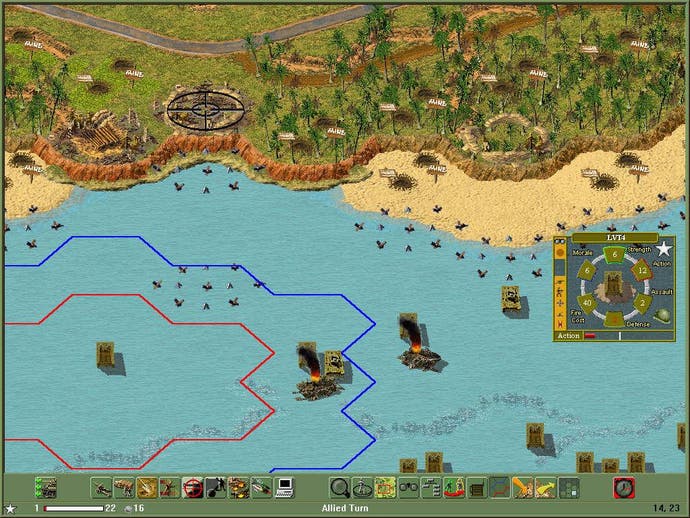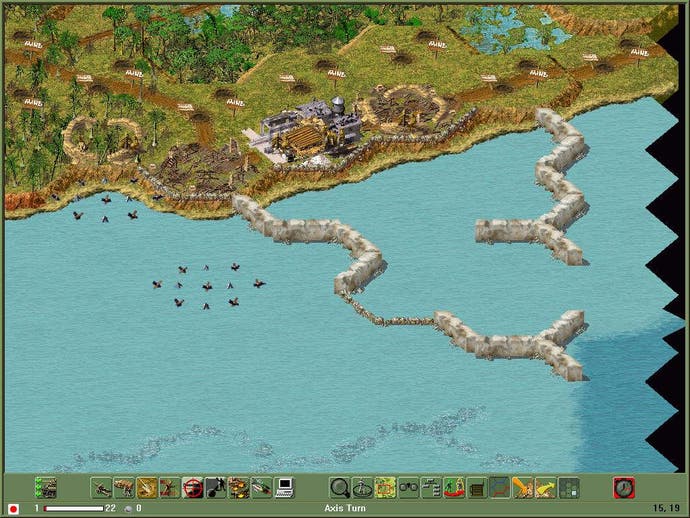Rising Sun
WW2 Pacific strategy game reviewed

Wargames
Mankind has an undeniable fascination with war. We watch images of unfolding conflicts, on the one hand clucking sympathetically about the suffering of the people on the ground, while inside we thrill at every deep boom of the heavy artillery, and shiver with excitement at the sharp cracking of assault rifles.
The media have exploited this facet of human nature since the beginning of time - our basic need for conflict is expressed most powerfully in warfare, and thousands of plays, novels and movies have fulfilled that need admirably, from Shakespeare's Macbeth to the latest Hollywood action flick. Most recently of all, computer games allow the player to enter into a wartime situation, either as an individual soldier or as the commander of an entire army.
All of these games - from the military authenticity of Counter Strike and Shogun to the exaggerated technological carnage of Unreal Tournament and Tiberian Sun - base their appeal on the fact that they bring the player into the battlefield, allowing them to become part of the action in the age old game of war.
While of course many different factors combine to create a good or a bad game, there is no doubt that immersion is a primary one - the ultimate aim of a game creator is to make the player feel part of the action to as large a degree as possible.

Board
Not so Rising Sun. This is the latest in a line of games from Talonsoft that recreate historic theatres of war, in this case the Pacific during World War II is the focus.
Any fan of military history will recognise the names of battlefields such as Guadalcanal, Manila and Tarawa, but rather than basing a real-time strategy game of tactics and resource management around this rich source material, Talonsoft have created a turn-based game played over maps made up of large hexagons which has more in common with military board games than it does with contemporary strategy wargames.
Starting a game of Rising Sun is like stepping into a timewarp, not back to the 1940's, as the developers might hope, but to the early 1990's, when most strategy games were two dimensional and based on moving pieces around on hexagons.
Rising Sun is admittedly a little more advanced than that - the battlefields in the game are based on actual overhead photographs of the terrain of the Pacific during the war, and concepts such as height and line-of-sight are implemented quite well. But at the end of the day, it is very hard to get away from the fact that this is a game which is not a million miles ahead of Civilisation 2 in terms of graphics, and whose gameplay mechanics are akin to those found in very simplistic table-top games.

Turn, Turn, Turn
The basic premise of all of the scenarios in Rising Sun is that your units are placed at one end of the map, and you are given a certain number of turns to complete an objective, such as the capture of a strategic position, or the destruction of certain enemy units.
Each of your units has a number of action points at the beginning of a turn, which can then be used to move or to shoot. Click on a unit, and the hexagons which it can see, move to, or shoot at are highlighted awaiting your orders. The main problem with the gameplay arises when you realise that many of the maps are very large indeed, and that unit movement is painfully slow. You will often find that the larger part of a game is taken up entirely with laboriously moving your units to the middle of the map, followed by a short bout of combat.
The combat itself isn't exactly worth writing home about, being a very staid affair indeed. Certain realistic touches are applied, such as the advantages of height and cover being well implemented, but other features of the lacklustre unit combat system will come across as annoying at best. For example, units that have come under fire can sometimes lose heart completely and refuse to move towards an enemy unit - a clumsy attempt at implementing unit morale, which was done much more successfully in Shogun and the Close Combat series.

Musical Squares
A special mention must go to the musical score, which is one of the most inappropriate and utterly terrible soundtracks that I have ever come across.
The music seems to jump about seemingly at random (possibly an attempt at doing dynamic music, although this is unclear), skipping merrily between themes, moods and tempos at a rate of knots.
One minute you are moving units to a dramatic "Ride Of The Valkyries" style march, the next you are opening fire on the enemy position to the strains some light-hearted "dancing with the pixies and faeries" music that would probably be more at home in EverQuest than in a game presenting itself as a realistic combat simulation.
Rising Sun plumbs new depths when it comes to soundtrack selection.

Conclusion
The TalonSoft series of wargames does have a certain hardcore following, mainly made up of older gamers who have moved from table-top wargames to PC gaming. Indeed, the (rather hefty) manual for Rising Sun carries a number of advertisements from companies selling war miniatures and the likes.
If you are one of these people, then you already know what to expect from a Talonsoft game, and you probably aren't reading this review out of anything but passing interest, since you will buy the game anyway. If so, rest assured that Rising Sun does have a wide variety of missions and units, and will probably be a good purchase for you.
If, however, you are in the majority of gamers who don't like table-top war games (and we aren't talking about Warhammer here, but dry military games), then you would be advised to steer well clear. Far from being the realistic simulation of warfare in the Pacific that it claims to be, Rising Sun is in fact nothing more than a relatively poor board game, albeit a board game wearing layers upon layers of cheap digital makeup.

